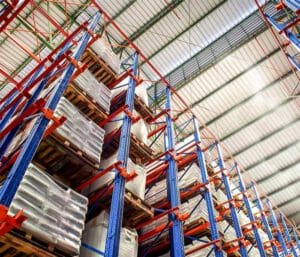
Advanced Handling & Storage Ltd
The Pallet Racking People

Pallet Racking Guidelines
The material handling industry is abundant with new technologies and innovations. In the background of all this fancy new technology is a variety of less exciting, but equally important equipment, including pallet racking and pallet racking guidelines.
With all of the moving parts of a material handling system, rack if often viewed as “just rack.” It is often the last part of a system to be considered and is usually seen as a simple piece of the puzzle. However, there are actually a multitude of different aspects that must be considered when designing and ordering pallet racking to ensure a proper fit for a material handling system. This is why it is important to allow ample time for industry experts to analyse the many aspects of a proper rack design.
The design of pallet rack systems can be broken down into 3 major elements as follows:
1) Details of the product being stored
2) Physical site variables
3) Rack design variables.
This article will take a quick look at each element.
Product Being Stored
Size and Weight of the Product – This is the most important aspect of designing pallet rack systems. Since racks are designed with a built-in safety factor, it is important not to inflate the weight of the product, which will increase the cost of the rack components.
Type and Construction of the Pallet – There are a couple of different kinds of Pallets which is why we need to know which type you are using – to choose the suitable sized pallet racking system.
Storage of Product on Pallet – If product overhangs the pallet, the racks may need to increase in width or depth to accommodate the overhang.

Pallet Racking Design
Definitions – An upright frame (1) is constructed of two vertical columns with bracing (2) between them. Horizontal beams (3) connect the uprights together and support the pallets.
Rack Profiles – A “profile” is a drawing that shows the distance between beam levels for each bay of rack. If there are long spans between beam levels, additional bracing may be required.
Reinforcement – Additional bracing of the upright frame may be required and is determined by the distance between beam levels and the seismic classification. This can include bracing that is thicker, bracing that has been doubled, and a different bracing pattern that is closer together.
Beam Design – Beam design is driven by the seismic classification which determines the size and type of connector and how the connectors are welded to the ends of the beams. The length of the beams is determined by establishing the clearances required between pallets as they are stored on the rack as well as the distance required between the pallets and the rack uprights. Typical clearances normally fall within 4” to 6”.
Closed Tube or Open Tube – This refers to the construction of the vertical columns of the upright frames. Columns can have an open back (“open tube”) or closed back (“closed tube”). Many times the choice is customer preference, but there can be advantages of one over the other depending on the application.
Structural Steel Racking – Structural steel may be utilized in lieu of formed steel racking, based on the application. Traditionally structural steel racking is more expensive than formed steel racking but can also provide increased load capacities if needed.
Column Punching – the holes that are punched in the face of the vertical columns to which the beams are connected vary greatly by manufacturer. This is important in case the punching needs to match existing pallet rack.
Pallet Racking Accessories – The most common accessories are wire decks, pallet support bars, column protectors, and end-of-aisle guarding. Please let your integrator know if these are required or desired for the application.
Pick-Up and Drop-Off Stations – Pallet racking is typically designed with one bay removed from the end of every other row so pallets can be temporarily stored on the floor until they can be put away inside the racks. These are referred to as P&D Stations (Pick-Up and Drop-Off Stations).

Get in Touch with Advanced Handling & Storage
If you want to maximise your warehouse space through the use of second hand or new pallet racking, please don’t hesitate to get in touch with us on 0800 345 7088 or send an email to [email protected]
Make sure you follow #TeamAdvanced on Social media for all our latest news and offers!
Like us on Facebook
Follow us on Twitter
Connect with us on LinkedIn
Subscribe to Our YouTube channel
Follow us on GooglePlus
Read our other blogs on Medium
Follow us on Instagram